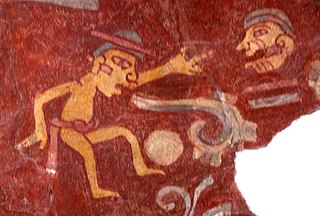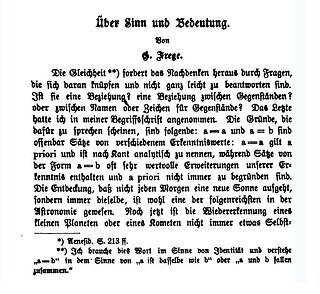Related Research Articles

Language is a structured system of communication that consists of grammar and vocabulary. It is the primary means by which humans convey meaning, both in spoken and written forms, and may also be conveyed through sign languages. Human language is characterized by its cultural and historical diversity, with significant variations observed between cultures and across time. Human languages possess the properties of productivity and displacement, which enable the creation of an infinite number of sentences, and the ability to refer to objects, events, and ideas that are not immediately present in the discourse. The use of human language relies on social convention and is acquired through learning.
A morpheme is the smallest meaningful constituent of a linguistic expression. The field of linguistic study dedicated to morphemes is called morphology.
In linguistics, morphology is the study of words, including the principles by which they are formed, and how they relate to one another within a language. Most approaches to morphology investigate the structure of words in terms of morphemes, which are the smallest units in a language with some independent meaning. Morphemes include roots that can exist as words by themselves, but also categories such as affixes that can only appear as part of a larger word. For example, in English the root catch and the suffix -ing are both morphemes; catch may appear as its own word, or it may be combined with -ing to form the new word catching. Morphology also analyzes how words behave as parts of speech, and how they may be inflected to express grammatical categories including number, tense, and aspect. Concepts such as productivity are concerned with how speakers create words in specific contexts, which evolves over the history of a language.

A synonym is a word, morpheme, or phrase that means exactly or nearly the same as another word, morpheme, or phrase in a given language. For example, in the English language, the words begin, start, commence, and initiate are all synonyms of one another: they are synonymous. The standard test for synonymy is substitution: one form can be replaced by another in a sentence without changing its meaning. Words are considered synonymous in only one particular sense: for example, long and extended in the context long time or extended time are synonymous, but long cannot be used in the phrase extended family. Synonyms with exactly the same meaning share a seme or denotational sememe, whereas those with inexactly similar meanings share a broader denotational or connotational sememe and thus overlap within a semantic field. The former are sometimes called cognitive synonyms and the latter, near-synonyms, plesionyms or poecilonyms.
Lexical semantics, as a subfield of linguistic semantics, is the study of word meanings. It includes the study of how words structure their meaning, how they act in grammar and compositionality, and the relationships between the distinct senses and uses of a word.

In the philosophy of language, the distinction between sense and reference was an idea of the German philosopher and mathematician Gottlob Frege in 1892, reflecting the two ways he believed a singular term may have meaning.
In linguistics and philosophy, the denotation of an expression is its literal meaning. For instance, the English word "warm" denotes the property of having high temperature. Denotation is contrasted with other aspects of meaning including connotation. For instance, the word "warm" may evoke calmness or coziness, but these associations are not part of the word's denotation. Similarly, an expression's denotation is separate from pragmatic inferences it may trigger. For instance, describing something as "warm" often implicates that it is not hot, but this is once again not part of the word's denotation.
In generative linguistics, Distributed Morphology is a theoretical framework introduced in 1993 by Morris Halle and Alec Marantz. The central claim of Distributed Morphology is that there is no divide between the construction of words and sentences. The syntax is the single generative engine that forms sound-meaning correspondences, both complex phrases and complex words. This approach challenges the traditional notion of the Lexicon as the unit where derived words are formed and idiosyncratic word-meaning correspondences are stored. In Distributed Morphology there is no unified Lexicon as in earlier generative treatments of word-formation. Rather, the functions that other theories ascribe to the Lexicon are distributed among other components of the grammar.
Semantic prosody, also discourse prosody, describes the way in which certain seemingly neutral words can be perceived with positive or negative associations through frequent occurrences with particular collocations. Coined in analogy to linguistic prosody, popularised by Bill Louw.

A word is a basic element of language that carries meaning, can be used on its own, and is uninterruptible. Despite the fact that language speakers often have an intuitive grasp of what a word is, there is no consensus among linguists on its definition and numerous attempts to find specific criteria of the concept remain controversial. Different standards have been proposed, depending on the theoretical background and descriptive context; these do not converge on a single definition. Some specific definitions of the term "word" are employed to convey its different meanings at different levels of description, for example based on phonological, grammatical or orthographic basis. Others suggest that the concept is simply a convention used in everyday situations.
Cognitive semantics is part of the cognitive linguistics movement. Semantics is the study of linguistic meaning. Cognitive semantics holds that language is part of a more general human cognitive ability, and can therefore only describe the world as people conceive of it. It is implicit that different linguistic communities conceive of simple things and processes in the world differently, not necessarily some difference between a person's conceptual world and the real world.
aUI is a philosophical, a priori language created in the 1950s by W. John Weilgart, Ph.D. a philosopher and psychoanalyst originally from Vienna, Austria. He described it as "the Language of Space", connoting universal communication, and published the fourth edition of the textbook in 1979; a philosophic description of each semantic element of the language was published in 1975.
In structuralism-influenced studies of mythology, a mytheme is a fundamental generic unit of narrative structure from which myths are thought to be constructed—a minimal unit that is always found shared with other, related mythemes and reassembled in various ways ("bundled") or linked in more complicated relationships. For example, the myths of Greek Adonis and Egyptian Osiris share several elements, leading some scholars to conclude that they share a source, i.e. images passed down in cultures or from one to another, being ascribed new interpretations of the action depicted, as well as new names in various readings of icons.
A tagmeme is the smallest functional element in the grammatical structure of a language. The term was introduced in the 1930s by the linguist Leonard Bloomfield, who defined it as the smallest meaningful unit of grammatical form. The term was later adopted, and its meaning broadened, by Kenneth Pike and others beginning in the 1950s, as the basis for their tagmemics.
Semantic change is a form of language change regarding the evolution of word usage—usually to the point that the modern meaning is radically different from the original usage. In diachronic linguistics, semantic change is a change in one of the meanings of a word. Every word has a variety of senses and connotations, which can be added, removed, or altered over time, often to the extent that cognates across space and time have very different meanings. The study of semantic change can be seen as part of etymology, onomasiology, semasiology, and semantics.
In linguistics, a word sense is one of the meanings of a word. For example, a dictionary may have over 50 different senses of the word "play", each of these having a different meaning based on the context of the word's usage in a sentence, as follows:
We went to see the playRomeo and Juliet at the theater.
The coach devised a great play that put the visiting team on the defensive.
The children went out to play in the park.
In linguistics, semantic analysis is the process of relating syntactic structures, from the levels of words, phrases, clauses, sentences and paragraphs to the level of the writing as a whole, to their language-independent meanings. It also involves removing features specific to particular linguistic and cultural contexts, to the extent that such a project is possible. The elements of idiom and figurative speech, being cultural, are often also converted into relatively invariant meanings in semantic analysis. Semantics, although related to pragmatics, is distinct in that the former deals with word or sentence choice in any given context, while pragmatics considers the unique or particular meaning derived from context or tone. To reiterate in different terms, semantics is about universally coded meaning, and pragmatics, the meaning encoded in words that is then interpreted by an audience.
Nanosyntax is an approach to syntax where the terminal nodes of syntactic parse trees may be reduced to units smaller than a morpheme. Each unit may stand as an irreducible element and not be required to form a further "subtree." Due to its reduction to the smallest terminal possible, the terminals are smaller than morphemes. Therefore, morphemes and words cannot be itemised as a single terminal, and instead are composed by several terminals. As a result, nanosyntax can serve as a solution to phenomena that are inadequately explained by other theories of syntax.

English nouns form the largest category of words in English, both in the number of different words and how often they are used in typical texts. The three main categories of English nouns are common nouns, proper nouns, and pronouns. A defining feature of English nouns is their ability to inflect for number, as through the plural –s morpheme. English nouns primarily function as the heads of noun phrases, which prototypically function at the clause level as subjects, objects, and predicative complements. These phrases are the only English phrases whose structure includes determinatives and predeterminatives, which add abstract-specifying meaning such as definiteness and proximity. Like nouns in general, English nouns typically denote physical objects, but they also denote actions, characteristics, relations in space, and just about anything at all. Taken all together, these features separate English nouns from other lexical categories such as adjectives and verbs.
In linguistics, a form-meaning mismatch is a natural mismatch between the grammatical form and its expected meaning. Such form-meaning mismatches happen everywhere in language. Nevertheless, there is often an expectation of a one-to-one relationship between meaning and form, and indeed, many traditional definitions are based on such an assumption. For example,
Verbs come in three tenses: past, present, and future. The past is used to describe things that have already happened. The present tense is used to describe things that are happening right now, or things that are continuous. The future tense describes things that have yet to happen.
References
- ↑ Pragmatic and syntagmatic aspects of phraseology, Krassnoff (in Russian)
- ↑ Stanojević, Maja (2009), "Cognitive synonymy: a general overview" (PDF), Facta Universitatis, Linguistics and Literature Series, 7 (2): 193–200.
Sources
- Bazell, Charles Ernest (1954). The sememe. in: Litera I. Istanbul. pp. 17–31.
{{cite book}}: CS1 maint: location missing publisher (link) Reprinted in: Hamp, Eric P.; Fred W. Householder; Robert Austerlitz, eds. (1966). Readings in linguistics II. University of Chicago Press. pp. 329–40. - Vakulenko, Serhii (2005). "The Notion of Sememe in the Work of Adolf Noreen". The Henry Sweet Society for the History of Linguistic Ideas Bulletin. 44 (1): 19–35. doi:10.1080/02674971.2005.11745606. S2CID 148074668.